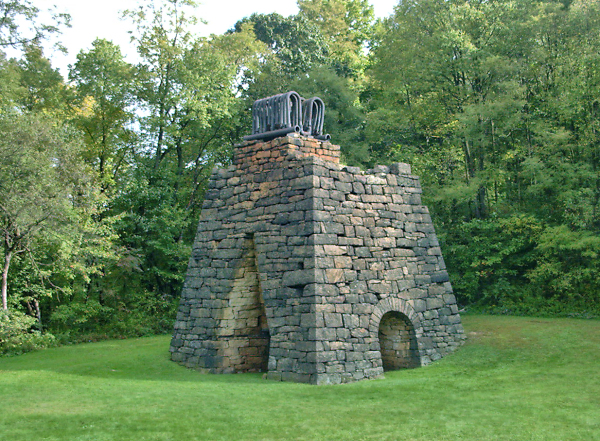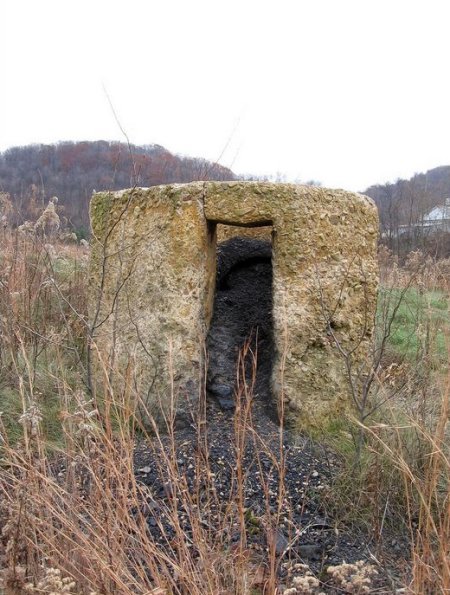VINTONDALE, PA
The coal company town of Vintondale was built in 1892 by the Vinton Colliery Company. The name was going to be Barker City when it was laid out by the Blacklick Land
Improvement Company, but it was changed to Vintondale. It was one of the few coal company towns in the Black Lick Field to have
beehive coke ovens. There were 152 of them. Mining was in the four foot thick Lower Kittanning ("B" a.k.a. "Miller") seam of coal. From 1901 to 1905, the Vintondale mines were
a property of Lackawanna Coal & Coke Co. By 1906, Vinton Colliery company was once again the owner and operator. Also, there was a longwall miner in use at the Vintondale mines at the incredibly early date of the 1910s.
In 1940 the Vinton Colliery Company reorganized into
Vinton Coal and Coke Company. Mining at Vintondale ended in 1968. However there was a small active strip mine on the mountain above
Vintondale when I visited it in 2003.
An anonymous American reader writes, "My great-grandfather immigrated from the coal mines of Northern Wales to the coal mines of Western
Pennsylvania in the 1880's. He started working in Lovedale, near Elizabeth, PA, then moved up to Coalglen, PA in Jefferson County. Lastly he worked as a mine Superintendent
in Vintondale, Pennsylvania. His illustrious and hardworking life bore he and his wife 13 children. One of his daughters corresponded with a cousin back in Wales and
sent postcards of the Vintondale mines circa 1906. I met (online) the descendant of this British cousin, who in turn emailed me scanned photos of these postcards.
They are truly a glimpse of a place and time that no longer exist."
The British cousin that he found online writes, "My name is Michelle I am from Shropshire, England, and it is my family who have shared the old postcards of Vintondale with you.
My Grandmother Gwen kept these things even though she had no idea who the author of the postcard was,or what connection she and her family had with Pennsylvania.
Unfortunately I lost my Grandmother Gwen in 2019 who I adored so much and in her name I decided to find out about her family.
It was in November 2020 during lockdown that I found my cousin in Pennsylvania on a genealogy website and we realised what our connection was.
These postcards were taken from my Grandmothers box of treasures and are now out on the world wide web for everybody to see.
and she honestly would never believe it.
She was Gwen Edwards nee Thomas,
A dedicated nurse during World War 2,
from Shropshire, England,
died 21st July 2019,
and these postcards are given in memory of a dearly loved and very much missed Nan and Mother."
Here are the postcards of Vintondale:
Paulette writes, "I was surprised to find your web site about coal fields. I was even more surprised to see a page on Vintondale. Such an
obscure, nowhere place and here it is on the internet! I was born and raised there....in 1947, so I came in when
things were coming to an end. I lived in a town that I didn't even know had
once had an undertaker or so many stores. I had no idea that so many people had filled that town at one time.
My father told us many stories from how he walked home in wet and frozen
clothes to how he got cheated in the number of cars he loaded. He started in
the mines at age 15 in Nanty-Glo and they moved to Vintondale in 1927.
He helped to establish the union in Vintondale and was the president of
Local 620 at one time, something he was proud of, I think. When he was old
he said he never dreamed in his youth that life would be so good for him in
old age, meaning the pension he got and black lung benefits."
Sources:
Fitzsimons, Gray, editor. Blair County and Cambria County, Pennsylvania; An Inventory of Historic Engineering and Industrial Sites. 1990.

Sep. 2003 image by author
Company-built houses along the road coming down the mountain into Vintondale.

Sep. 2003 image by author
Foundations of the machine shop are some of the very few remnants of the coal mining complex at Vintondale, shown here in the
middle of the Vintondale AMD (Acid Mine Drainage) Park. How many other coal towns have their own Acid Mine Drainage parks?

Sep. 2003 image by author
These cut stone walls lined the entry to the Mine No. 3 portal. As many as 590 miners worked at Vintondale during World War I.

Sep. 2003 image by author
This huge refuse pile was interesting and fun to walk across. It appears that the coal company stopped just short of
burying Black Lick Creek. But you should not walk
across hazardous refuse piles unless you are an
experienced refuse pile climber because they could be honeycombed in the middle from gob fires. No interesting fossils were found on the Vintondale slate dump.

Sep. 2003 image by author
Coal company houses on 4th Street.

Sep. 2003 image by author
The Eliza furnace on the edge of Vintondale was built in 1845 and only operated for a few years. The ironmaking operation
was too early to use the coal mined on Black Lick Creek. This furnace used charcoal.
By the time coal mining began in the area circa 1890, the furnace had been cold for four decades.

Nov. 2006 image by "Dazzled" via Flickr
Coal mining ruins at Vintondale. The photographer identified it as "coke oven remains." This was probably one of Lackawanna Steel
Company's eight experimental coke ovens.

2023 image courtesy of Willie Kramer
An underground shuttle car displayed along the Ghost Town Trail (former railroad) in Vintondale. Willie, the photographer,
writes, "To me this shuttle-car dates earlier than the modern JOY models I’ve found online because it doesn’t use a chain conveyor to move the load out of it. Instead, a pair of trap doors make up the bottom. This
would require the shuttle-car to drive onto a dumping ramp to release the load by gravity, dropping it onto a vehicle below the ramp (perhaps a truck or wagon)."

Sep. 2003 image by author

Image courtesy of Cindy Campbell
Cindy shares this photo of her grandfather, Russell Elvin Dodson (left, with dinner bucket), and an unnamed coal miner relaxing on the railroad track. He grew up in Vintondale, and, as a child, carried water
to the coal miners. Eventually, he became a supervisor at the Vintondale mines.

Image courtesy of Cindy Campbell
Russell Dodson's "tiger stripe" hard hat.

Image courtesy of Cindy Campbell
Cindy's mother, Florabelle Dodson Thatcher, as a young woman in Vintondale.

Gwen Edwards

"Washery at #6 mine where they wash the coal."

"Power house, washery and tipple #6 mine."

"Steel tipple at #1 mine where Papa works."

"Coal co. mine office."

"This is our depot. What do you think of it?"

"Part of our Main Street. X is Post Office."